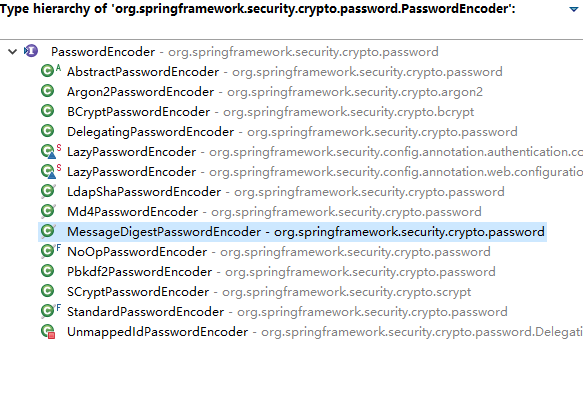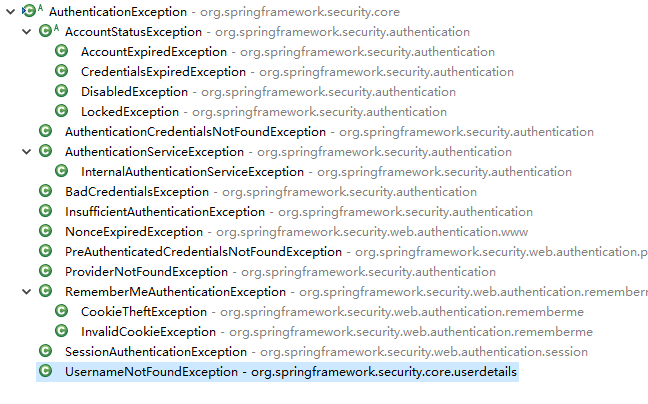# 会话管理笔记1
# 密码存储
# 暴力破解/字典/彩虹表
常见密文存储的几种方式:
- 明文
- hash(明文)
- hash(明文 + 盐)
盐的几种实现:
- 用户名 手机号等 每个账户不一样
- 统一的盐
- 随机盐(保存数据库)
- 随机盐(从密码取)
# 防止破解
没有绝对安全的网络,即使拿不到密码 也可以发送重放攻击
- 多次加盐取hash
- 使用更复杂的单向加密算法比如Bcrypt
- 使用https
- 风控系统
- 二次安全校验
- 接口调用安全校验
- 异地登录等
- 大额转账
# Bcrypt结构
# 密码加密
接口
PasswordEncoder
三个方法
/**
* Encode the raw password. Generally, a good encoding algorithm applies a SHA-1 or
* greater hash combined with an 8-byte or greater randomly generated salt.
用来加密
*/
String encode(CharSequence rawPassword);
/**
* Verify the encoded password obtained from storage matches the submitted raw
* password after it too is encoded. Returns true if the passwords match, false if
* they do not. The stored password itself is never decoded.
*
* @param rawPassword the raw password to encode and match
* @param encodedPassword the encoded password from storage to compare with
* @return true if the raw password, after encoding, matches the encoded password from
* storage
校验密码
*/
boolean matches(CharSequence rawPassword, String encodedPassword);
/**
* Returns true if the encoded password should be encoded again for better security,
* else false. The default implementation always returns false.
* @param encodedPassword the encoded password to check
* @return true if the encoded password should be encoded again for better security,
* else false.
是否需要再次加密
*/
default boolean upgradeEncoding(String encodedPassword) {
return false;
}
2
3
4
5
6
7
8
9
10
11
12
13
14
15
16
17
18
19
20
21
22
23
24
25
26
27
28
29
30
31
32
实现类
# 认证方式
不加密
@Bean
PasswordEncoder passwordEncoder() {
return NoOpPasswordEncoder.getInstance();
}
2
3
4
BCrypt
@Bean
public BCryptPasswordEncoder passwordEncoder() {
return new BCryptPasswordEncoder();
}
2
3
4
# JDBC用户存储
# 依赖
<dependency>
<groupId>org.springframework.boot</groupId>
<artifactId>spring-boot-starter-jdbc</artifactId>
</dependency>
<dependency>
<groupId>mysql</groupId>
<artifactId>mysql-connector-java</artifactId>
</dependency>
2
3
4
5
6
7
8
# 配置文件
spring.datasource.username=root
spring.datasource.password=840416
spring.datasource.url=jdbc:mysql:///mq?useUnicode=true&characterEncoding=UTF-8&serverTimezone=Asia/Shanghai
2
3
4
# 建表
Spring Security默认情况下需要两张表,用户表和权限表,可以参考
org.springframework.security.core.userdetails.jdbc.users.ddl
# 登录实现及用户注册
@Bean
protected UserDetailsService userDetailsService() {
JdbcUserDetailsManager manager = new JdbcUserDetailsManager(dataSource);
if(manager.userExists("yiming")) {
System.out.println("已注册");
}else {
manager.createUser(User.withUsername("yiming")
.password(new BCryptPasswordEncoder().encode("123"))
.roles("admin")
.build()
);
}
return manager;
}
2
3
4
5
6
7
8
9
10
11
12
13
14
15
16
17
18
或者
@Override
protected void configure(AuthenticationManagerBuilder auth) throws Exception {
JdbcUserDetailsManager manager = auth.
jdbcAuthentication()
.dataSource(dataSource).getUserDetailsService();
manager.createUser(User.withUsername("1112")
.password(new BCryptPasswordEncoder().encode("123"))
.roles("admin")
.build());
2
3
4
5
6
7
8
9
10
11
# mysql
create table users(username varchar(50) not null primary key,password varchar(500) not null,enabled boolean not null);
create table authorities (username varchar(50) not null,authority varchar(50) not null,constraint fk_authorities_users foreign key(username) references users(username));
create unique index ix_auth_username on authorities (username,authority);
2
3
4
5
# 如何使用mybatis/jpa查询用户
# 自定义用户登录查询
新建一个service实现UserDetailsService接口
@Service
public class UserService implements UserDetailsService{
@Override
public UserDetails loadUserByUsername(String username) throws UsernameNotFoundException {
// 在这里执行查询
System.out.println("开始查询数据源。。。");
if(new Random().nextBoolean()) {
throw new LockedException("用户已锁定");
}else {
throw new BadCredentialsException("我错了");
}
}
}
2
3
4
5
6
7
8
9
10
11
12
13
14
15
16
17
将service注入到配置
@Autowired
UserService userSrv;
@Override
protected void configure(AuthenticationManagerBuilder auth) throws Exception {
auth.userDetailsService(userSrv);
}
2
3
4
5
6
7
8
# 自定义用户权限校验
# 校验器
@Service
public class MyAuthprovider implements AuthenticationProvider {
@Autowired
UserService userSrv;
@Override
public Authentication authenticate(Authentication authentication) throws AuthenticationException {
// 密码校验
System.out.println("开始自定义验证~~~~");
System.out.println(authentication);
//查询用户名
UserDetails userDetails = userSrv.loadUserByUsername("xxx");
// 密码加密器
BCryptPasswordEncoder passwordEncoder = new BCryptPasswordEncoder();
// 密码加密
String encodePass = passwordEncoder.encode(authentication.getCredentials().toString());
UsernamePasswordAuthenticationToken authenticationToken = new UsernamePasswordAuthenticationToken(userDetails, encodePass, userDetails.getAuthorities());
return authenticationToken;
}
@Override
public boolean supports(Class<?> authentication) {
// TODO Auto-generated method stub
return true;
}
}
2
3
4
5
6
7
8
9
10
11
12
13
14
15
16
17
18
19
20
21
22
23
24
25
26
27
28
29
30
31
32
33
34
35
# 配置校验器
JdbcUserDetailsManager manager = auth.
jdbcAuthentication()
.dataSource(dataSource).getUserDetailsService();
auth.authenticationProvider(new MyAuthprovider());
2
3
4
5
6
# 记住我
http.
// 哪些 地址需要登录
authorizeRequests()
//所有请求都需要验证
.anyRequest().authenticated()
.and()
.formLogin()
.and()
.rememberMe()
.and()
.csrf().disable()
2
3
4
5
6
7
8
9
10
11
# 同一用户多地点登录
此配置和记住我有冲突
# 踢掉其他已登录的用户
http.
// 哪些 地址需要登录
authorizeRequests()
//所有请求都需要验证
.anyRequest().authenticated()
.and()
.formLogin()
.and()
.csrf().disable()
.sessionManagement()
.maximumSessions(1);
2
3
4
5
6
7
8
9
10
11
# 禁止其他终端登录
http.
// 哪些 地址需要登录
authorizeRequests()
//所有请求都需要验证
.anyRequest().authenticated()
.and()
.formLogin()
.and()
.csrf().disable()
.sessionManagement()
.maximumSessions(1)
.maxSessionsPreventsLogin(true)
2
3
4
5
6
7
8
9
10
11
12
及时清理过期session
@Bean
HttpSessionEventPublisher httpSessionEventPublisher() {
return new HttpSessionEventPublisher();
}
2
3
4
# 防火墙
# ip白名单
# 指定ip可以不登录
http.
// 哪些 地址需要登录
authorizeRequests()
//所有请求都需要验证
.anyRequest().authenticated()
.antMatchers("/ip1").hasIpAddress("127.0.0.1")
2
3
4
5
6
7
# 禁止ip访问
用Filter 实现、或者用HandlerInterceptor 实现
# StrictHttpFirewall
spring security 默认使用StrictHttpFirewall限制用户请求
# method
缺省被允许的HTTP method有 [DELETE, GET, HEAD, OPTIONS, PATCH, POST, PUT]
# URI
在其requestURI/contextPath/servletPath/pathInfo中,必须不能包含以下字符串序列之一 :
["//","./","/…/","/."]
# 分号
;或者%3b或者%3B
// 禁用规则
setAllowSemicolon(boolean)
2
3
# 斜杠
%2f`或者`%2F
// 禁用规则
setAllowUrlEncodedSlash(boolean)
2
3
# 反斜杠
\或者%5c或者%5B
// 禁用规则
setAllowBackSlash(boolean)
2
3
# 英文句号
%2e或者%2E
// 禁用规则
setAllowUrlEncodedPeriod(boolean)
2
3
# 百分号
%25
// 禁用规则
setAllowUrlEncodedPercent(boolean)
2
3
# 防火墙与sql注入
' ; -- % 多数非法字符已经在请求的参数上被禁用
为啥用户名不能有特殊字符
preparestatement
awf前端拦截
# 自定义配置
# 指定登录的action
.loginProcessingUrl("/login")
# 指定登录成功后的页面
//直接访问登录页面时返回的地址,如果访问的是登录页的话返回指定的地址
.defaultSuccessUrl("/",true)
//必须返回指定地址
.defaultSuccessUrl("/",true)
# 指定错误页
//指定错误页
.failureUrl("/error.html?error1")
# 注销登录
# 默认方式
<a href="/logout">GET logout</a>
<br />
<form action="/logout" method="post">
<input type="hidden" th:name="${_csrf.parameterName}" th:value="${_csrf.token}" />
<input type="submit" value="POST Logout"/>
</form>
2
3
4
5
6
# 自定义url
.and()
.logout()
.logoutUrl("/out")
2
3
# 增加退出处理器
.addLogoutHandler(new LogoutHandler() {
@Override
public void logout(HttpServletRequest request, HttpServletResponse response, Authentication authentication) {
// TODO Auto-generated method stub
System.out.println("退出1");
}
})
.addLogoutHandler(new LogoutHandler() {
@Override
public void logout(HttpServletRequest request, HttpServletResponse response, Authentication authentication) {
// TODO Auto-generated method stub
System.out.println("退出2");
}
})
2
3
4
5
6
7
8
9
10
11
12
13
14
15
16
17
18
19
# 登录成功处理器
不同角色 跳转到不同页面
.successHandler(new AuthenticationSuccessHandler() {
@Override
public void onAuthenticationSuccess(HttpServletRequest request, HttpServletResponse response,
Authentication authentication) throws IOException, ServletException {
// TODO Auto-generated method stub
System.out.println("登录成功1");
// 根据权限不同,跳转到不同页面
request.getSession().getAttribute(name)
request.getRequestDispatcher("").forward(request, response);
}
})
其中 Authentication 参数包含了 用户权限信息
# 登录失败处理器
.failureHandler(new AuthenticationFailureHandler() {
@Override
public void onAuthenticationFailure(HttpServletRequest request, HttpServletResponse response,
AuthenticationException exception) throws IOException, ServletException {
// TODO Auto-generated method stub
exception.printStackTrace();
request.getRequestDispatcher(request.getRequestURL().toString()).forward(request, response);
}
})
2
3
4
5
6
7
8
9
10
可以限制登录错误次数
# 常见登录异常
LockedException 账户被锁定
CredentialsExpiredException 密码过期
AccountExpiredException 账户过期
DisabledException 账户被禁用
BadCredentialsException 密码错误
UsernameNotFoundException 用户名错误
# 访问权限
访问权限可以配置URL匹配用户角色或权限
http.authorizeRequests()
.antMatchers("/admin/**").hasRole("admin")
.antMatchers("/user/**").hasRole("user")
@Bean
# Ant 风格路径表达式
| 通配符 | 说明 |
|---|---|
| ? | 匹配任何单字符 |
| * | 匹配0或者任意数量的字符 |
| ** | 匹配0或者更多的目录 |
# 例子
| URL路径 | 说明 |
|---|---|
| /app/*.x | 匹配(Matches)所有在app路径下的.x文件 |
| /app/p?ttern | 匹配(Matches) /app/pattern 和 /app/pXttern,但是不包括/app/pttern |
| /**/example | 匹配(Matches) /app/example, /app/foo/example, 和 /example |
| /app/**/dir/file.* | 匹配(Matches) /app/dir/file.jsp, /app/foo/dir/file.html,/app/foo/bar/dir/file.pdf, 和 /app/dir/file.java |
| /**/*.jsp | 匹配(Matches)任何的.jsp 文件 |
# 最长匹配原则
最长匹配原则(has more characters) 说明,URL请求/app/dir/file.jsp,现在存在两个路径匹配模式/**/.jsp和/app/dir/.jsp,那么会根据模式/app/dir/*.jsp来匹配
# 匹配顺序
security像shiro一样,权限匹配有顺序,比如不能把.anyRequest().authenticated()写在其他规则前面
# 权限继承
RoleHierarchy roleHierarchy() {
RoleHierarchyImpl impl = new RoleHierarchyImpl();
impl.setHierarchy("ROLE_admin > ROLE_user");
return impl;
}

